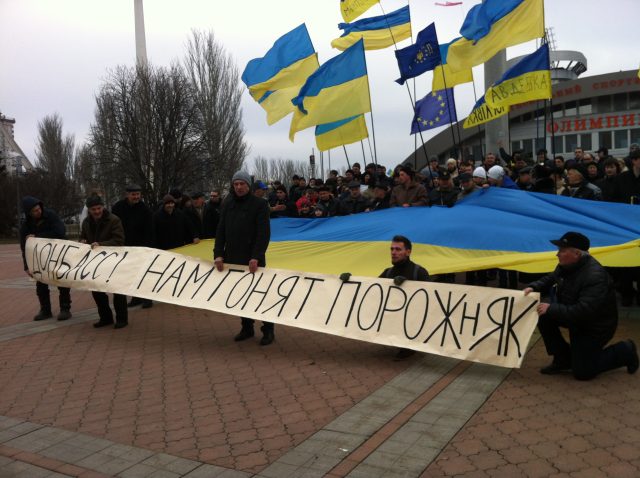
The EuroMaidan started in Kyiv on the evening of November 21st 2013. Throughout the subsequent weeks it turned into a true revolution – one that changed Ukraine’s political system and its geopolitical vector. Less known, however, is the fact that EuroMaidan went beyond the Independence Square in Kyiv. It also took place in eastern Ukraine.
The Maidan movement in Ukraine began in 1990 with student protests in Kyiv which became known as the Revolution on Granite. It continued with the Orange Revolution in 2004 and culminated with EuroMaidan in 2013-2014. The movement continues today as part of the process of building a new Ukrainian nation but it has roots in the centuries-long tradition of Ukrainian resistance to Russian aggression. Equally important, the Maidan movement continues the tradition of the Ukrainian Helsinki Group (founded in 1976) that aims to protect and promote human rights and civil liberties. It includes a right to live, non-discrimination, freedom of peaceful gatherings, freedom of speech and freedom of association. Through its activity, the group built a certain distance between Ukraine and the Kremlin and undertook the process of bringing Ukraine back to the western world.
Courage and fear
The EuroMaidan, a protest against the decision of Ukrainian authorities to halt the process of Ukraine’s integration with Europe, began in Kyiv on the evening of November 21st 2013. Throughout the subsequent weeks, it turned into a true revolution; one that changed Ukraine’s political system and geopolitical vector. What is less known, however, is that the first EuroMaidan assemblies in Donetsk and Kharkiv took place on the very same day as the protest in Kyiv. Demonstrations were organised in Luhansk three days later. This is proof that EuroMaidan went beyond the Independence Square in Kyiv. It also took place in eastern Ukraine, a region where outrageous violations of human rights occurred – incidents that received very little media coverage.
It is common knowledge that the Donbas region (which includes Donetsk and Luhansk oblasts) was a stronghold for the Party of Regions and its leader Viktor Yanukovych. This group, popularly known as “the family”, had tight control over the region. It could crush any form of dissent, brutally and recklessly. Hence, all demonstrations that were organised in eastern cities at the time were acts of great courage. Such were the 150-plus protests recorded between 2011 and 2013. They mostly consisted of people who were against the closing of schools, environmental pollution and the deterioration of public transport infrastructure. Miners and firefighters, who faced serious health problems due to the 1986 Chernobyl disaster, also protested against restrictions of their social benefits. They tried to set up a tent camp in Donetsk in November 2011, but were quickly dispersed by police. Sadly a 68-year-old miner, named Gennady Konoplyov, paid the highest price – he was killed by the police raid.

Not surprisingly, the way in which protesters were brutally treated by authorities created an omnipresent sense of fear. А group of students in 2008 who proposed renaming Donetsk National University after Vasyl Stus – a famous Ukrainian poet, human rights activist and political prisoner. Not only did the university administration refuse the students’ petition, but they also reported the leaders of the initiative to the police. Interrogation and intimidation tactics were used against the students. It took eight years (including a relocation to Vinnytsia) for the university to change its name. Unfortunately one of the initiators, Yuriy Marushchak, did not live to see it. He was killed in the Ilovaisk offensive in August 2014.
Fear also explains why EuroMaidan assemblies in Donbas were very few in numbers: people were being intimidated and dispersed from gatherings by authorities. In January 2014, for example, protesters in Donetsk became targets of attack coordinated by Armen Sarkisyan, a top gangster from the neighbouring town. Similarly, in Luhansk, EuroMaidan was attacked by “Afghan war veterans” – groups that later joined Russian occupation forces.
In spring 2014 after Russia’s annexation of Crimea and the launching of the “Russian Spring” offensive, people rallied throughout the country to express support for a united Ukraine. They were outraged by the war. In Donbas these assemblies were violently dispersed by criminals who had arrived in buses from neighbouring Russia. In March, during a peaceful assembly at the central Lenin Square in Donetsk, a local Ukrainian youth activist named Dmytro Cherniavsky was killed. His death was followed by three other protesters who were also killed by Russian aggressors. Their deaths, however, were never reported by the terrorised relatives.
Breakthrough in Kharkiv
Kharkiv is Ukraine’s second largest city. It is located 40 kilometres from the Russian-Ukrainian border, which made it an easy target for Russian aggression. Here, the methods used by the aggressors were similar to those seen in Donbas. However, the outcome differed. Protests in Kharkiv, historically speaking, have been numerous and regular. They would usually peak with huge rallies involving tens of thousands to hundreds of thousands of people. They were as large as the anti-communist protests in 1990, the 2004 protests against rigged elections, and the February 22th rally in 2014 (when Yanukovych fled to Russia). In between these large-scale events, there were some smaller street protests against police impunity, corrupt courts, environmental dangers, cruelty to animals, demolition of historical monuments, and restrictions on entrepreneurial freedom. Despite the protests being relatively small-scale, city government (controlled by the Party of Regions) restricted the number of peaceful assemblies nationwide between 2011 and 2013.
A breakthrough moment was thus the November 2013 assembly called “For a European Kharkiv”. Their message to authorities was that a departure away from European integration would lead to a disaster. As a matter of fact, this gathering initiated daily protests from November to the following March. Attendances varied between 200 to 500 people on weekdays and between 2,000 to 15,000 people on weekends. Based on the photos, videos and Google Analytics it can be estimated that at least 70,000 individuals took part in the Kharkiv protests, which is around five per cent of the city’s population – the lowest threshold for social change.
The uniqueness of Kharkiv’s EuroMaidan was that all the major opposition parties refused to take responsibility. Activities were coordinated by a public council (consisting of 40 members representing NGOs, the Democratic Alliance party and a number of individuals). The Maidan Monitoring Information Center was one of the NGOs involved. Most importantly, information about the undertaken activities and the council’s members were transparent and presented to the public. Facts and information on fundraising and spending were published daily, while plans for future action were announced. Virtually anyone could speak into the microphone during the weekday rallies. The coordinating committee supplied health and safety equipment, printed flags and flyers, and sponsored trips for those who wanted to go to the EuroMaidan in Kyiv. Music and poetry festivals were also organised and were attended by artists from other cities. The objective of the coordinating committee was to promote the idea of a European Ukrainian Kharkiv, and to say that nobody should be fearful in expressing their political views in public.
Forum of Maidans
EuroMaidan protests were not limited to Kyiv and Kharkiv. They were also held regularly in other Ukrainian towns. For this reason, EuroMaidan Kharkiv decided, by unanimous vote of the public assembly, to establish a Forum of all the EuroMaidans. It first gathered in Kharkiv in January 2014 and was attended by delegates from 42 cities. Shockingly, the opposition leaders in Kyiv labelled the forum a provocation of the ruling regime, which resulted in not a single politician attending. However, many activists, experts from Kyiv, politicians from Poland and US diplomats were present
The forum received more coverage in international media than Ukrainian national media. A local branch of the ruling Party of Regions tried to obstruct the event by organising bandits who tried to break down the doors of the church where the opening session was being held. Other examples of violence included: grenades being thrown at a bookstore where artists were discussing joint projects; a volunteer guard who was savagely beaten by a gangster; and electricity outages in the streets during the march. Such acts, not surprisingly, caught the attention of the foreign media. Despite the total national media blackout, the events still became known across the country. In general, people left Kharkiv with a greater determination to fight government oppression and a willingness to coordinate efforts on a nationwide scale.
One evening in February 2014 Yanukovych fled Kyiv and arrived in Kharkiv, where the Party of Regions attempted to organise an assembly of representatives from eastern and southern Ukraine. To everyone’s surprise, a large number of EuroMaidan supporters surrounded the Palace of Sports where the assembly was taking place. At that time, Kharkiv had no police forces capable of managing large crowds, as many units had been relocated to Kyiv. As Yanukovych fled to Russia, the assembly finished before the planned time, but without any decision. Participation in this rally was estimated to be around 30,000 people.
In addition, many people who did not take part in the EuroMaidan-Kharkiv activities during that revolutionary winter still watched the developments unfold very closely. Some understood the EuroMaidan cause much better after the annexation of Crimea; others when 106 people were hospitalised in March 2014 following the beating by Russians in the city’s central square. For others it was after piles of Ukrainian books were burned on the street; while for some others it was when they witnessed the refugees arriving from the self-proclaimed “Donetsk and Luhansk people’s republics”.
A stronghold of Ukraine
There is no doubt that Russia tried to inspire anti-Ukrainian activity in Kharkiv, which included waves of mass violence, explosions, provocations and various acts of terror. They even bused criminals into the city to wreak havoc. Kharkiv, however, remains a stronghold of Ukraine, largely thanks to the social mobilisation of EuroMaidan. Characteristically, starting on March 1st 2014, the Kharkiv law enforcement did not counteract Russian terrorists for 40 days. They acted as if they were on an Italian strike, waiting to see which side would win. This passivity led civilians to organise voluntary defence units, such as Kharkiv-1 and Slobozhanshchyna, which is said to have prevented the old corrupt police force from defecting to the Russians (as was the case in Donbas).
Clearly, the first volunteer military units needed equipment, clothes, food and medication, but the Ukrainian state could only supply them with old armaments. As a result, all the supplies that volunteers obtained came from friends and colleagues who mostly launched grassroots fundraising campaigns. The fundraisers copied the transparent financial reporting procedures (introduced by EuroMaidan-Kharkiv), and thus initiated a new trend that spread across Ukraine. The fundraisers published a list of needs, expenses and even copies of invoices, which built trust and ensured that donations covered necessities like boots, binoculars, fuel and tyres. A young woman from Kharkiv’s “Help Army” group said at a press conference that “After I have fixed an armoured vehicle with my own hands I started to believe that I am capable of anything.”
It took more than a year for the Ukrainian government to equip the military and provide adequate supplies. The volunteer-based assistance that was organised turned into a countrywide movement, with most of the supplies going through Kharkiv. The success of this operation would not have been possible without the co-operation of activists from different towns that were established during EuroMaidan.
The volunteers also organised a special meeting place at the Kharkiv railway station to welcome the inflow of internally displaced persons (IDPs) from Donbas as a result of the war. The “Station Kharkiv” group helped newcomers find food, clothing and shelter. It also offered assistance during the adaptation process and helped those seeking employment. Again, the state was in no position to tackle the situation and it took almost one year before appropriate institutions were set up. The military hospital in Kharkiv was able to accommodate a large number of wounded soldiers from the frontlines, but it lacked proper equipment, medication, clothes and food. As a response, local volunteers organised a 24/7 patrol in the hospital by helping out with the transportation of wounded soldiers and acquiring expensive medical equipment.
Uniquely Ukrainian
Assistance to the Ukrainian Army expanded beyond the Ukrainian border. The diaspora organised fundraisers in the United States, Canada, Israel and a number of EU states. It was during EuroMaidan and its aftermath that many people began to feel, for the first time in their lives, that they were truly Ukrainian. By July 2014 the Ukrainian Army liberated a large part of Donbas. At that time most activists from Kharkiv were helping refugees from the regained territories. Many people started to realise that it was not enough to protect the region, but safety depended on peaceful relations among people in Donbas. The first Ukrainian assembly in the liberated city of Kramatorsk, which became the administrative centre of the Donetsk region, was organised on July 27th 2014. It was the work of a hundred Kharkiv activists who travelled there and taught the locals how to organise peaceful gatherings. Many people in Donbas were asking for Ukrainian flags, and Kharkiv businesses began producing them. The huge demand for flags was only met by the end of 2015.
Performance artists regularly entertained the frontline military regiments. A well-known poet, Serhiy Zhadan, one of the coordinators of EuroMaidan-Kharkiv, collected and delivered books to the military and children of Donbas. This humanitarian traffic has never stopped. Even today EuroMaidan-Kharkiv and the people it has inspired continue to promote Ukraine and Europe in these areas.
Another unique phenomenon during EuroMaidan was the participation of football fans, or Ultras. As most EuroMaidan activists were not prepared to physically fight they were easy targets of organised crime. With succours came the Ultras, who actually had experience of resisting the police as they routinely fought each other. The Ultras of Donetsk came to protect the EuroMaidan in January 2014 after two activists had been beaten by strangers. The beatings happened on the watch of the passive Donetsk police. In Luhansk and Kharkiv local Ultras also started to protect peaceful protesters. Thanks to the Ultras of Donetsk and Mariupol Russia’s first attempt to occupy the Mariupol City Hall in April 2014 failed.
By the end of February the Ultras of all Ukrainian clubs declared a truce, vowing not to fight each other and to defend Ukraine. They have never broken this pledge. Violence at football matches stopped and new traditions were established: patriotic choirs, banners during matches, and joint club marches before matches. In March 2014 a Vladimir Putin chant – by the Ultras of Metalist Kharkiv and Shakhtar Donetsk clubs in Kharkiv – was first heard; it became the most vocal symbol of resistance to Russian aggression. Most Ultras from Donetsk, Luhansk and Kharkiv joined the army as volunteers. The legendary trainer of several Ukrainian clubs, Myron Markevych, regularly visits the Ultras in the army to show his support and encouragement.
The most important, uniquely Ukrainian, transformation that has been taking place since EuroMaidan is the continued work of volunteers who have stepped in where the state has failed, and they are performing the functions of the public authorities without being part of the old corrupt system. They are the true creators of the new Ukrainian state. Some of them have joined the government to implement the practices they developed as volunteers.
And yet, the war in Donbas continues. The position of the Ukrainian army is continuously under attack. They have become a true shield, restraining a foreign offensive against Ukraine. Ukrainians are continuing to fight for the values they expressed their commitment to on that chilly night on November 21st 2013.
Nataliya Zubar is Chair of Maidan Monitoring Information Center, member of Euromaidan Kharkiv coordinating council
Vitaliі Ovcharenko is Coordinator of Donbas branch of Maidan Monitoring Information Center, activist of Euromaidan Donetsk, Ph.D in History
Original publication in New Eastern Europe Issue 1 2017: The Art of Revolution
See the photos that illustrate the story







